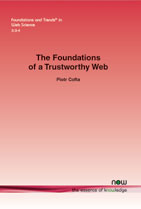The Foundations of a Trustworthy Web
By Piotr Cofta, , piotr.cofta@cofta.net
Abstract
It is trivial to say that the Web has changed the lives of the majority of us. There is no activity that has not been touched by the Web (directly or indirectly) and — in this process — somehow altered by it. The Web (and other large ICT mega-systems) permeates our lives regardless of our awareness of it and whether we like it or not. We increasingly depend on it, and thus we would like to be able to trust it. Further, we would like it to be trustworthy — and these two constructs do not always go hand in hand. There is a separate monograph [33] that discusses trust and trustworthiness. This one provides a foundation for this discussion — a model.
In order to systematically discuss the Web we have to have a model of it. However, a technical model does not suffice, as the Web is not only a technical but also a social phenomenon, embodied in technology. As the ultimate goal is to discuss trustworthiness of the Web, it would be beneficial to model the Web from the social perspective and to position the Web as a component of social practices — the component that interferes with them. This requires a model of society as well as an analysis of how the Web affects this model. This monograph does just that: it takes a particular model of society, extends it in a way that is relevant to the Web and defines the Web by systematically observing potential (and actual) changes.
This monograph goes one step further by asking the question what the Web look should like to be more relevant to its social function — if there is one. Again, the objective of this discussion is to facilitate a trustworthy web, as it is much easier to agree what a trustworthy web should look like if we know what the Web is for. The answer to this question leads to some practical design guidelines discussed here, whether they are technical, managerial or related to the governance of the Web. It is not a blueprint for a 'better' Web, but it is a discussion of the Web that may be more relevant to society — and hopefully more trustworthy in satisfying that society's needs.
The Foundations of a Trustworthy Web
The Web is shaping the way we communicate and live. It would therefore be beneficial to have a truly trustworthy Web. However, a systematic model of our relationship with the Web is missing, and this makes such a trustworthy Web an elusive target. The Foundations of a Trustworthy Web presents a thorough description of a model that enables the systematic analysis of the impact that the Web has on society, thus facilitating a discussion about the construction of a trustworthy Web. It is a self-contained introduction to another book, The Trustworthy and Trusted Web by the same author. The model presented in this monograph incorporates the Web into the theory of social systems, and analyses how the existence of the Web alters the way in which society creates its reality. Against this background, it defines the position and role of trust and trustworthiness, as well as the social function of the Web, all in the dual perspective of social sciences and technology. This is an excellent book for anyone who is interested in learning about modelling the relationship between society and information technology, specifically the Web. It is comprehensive and informative in analysing the current situation while also delivering a visionary yet pragmatic exploration of the social purpose of the Web.
